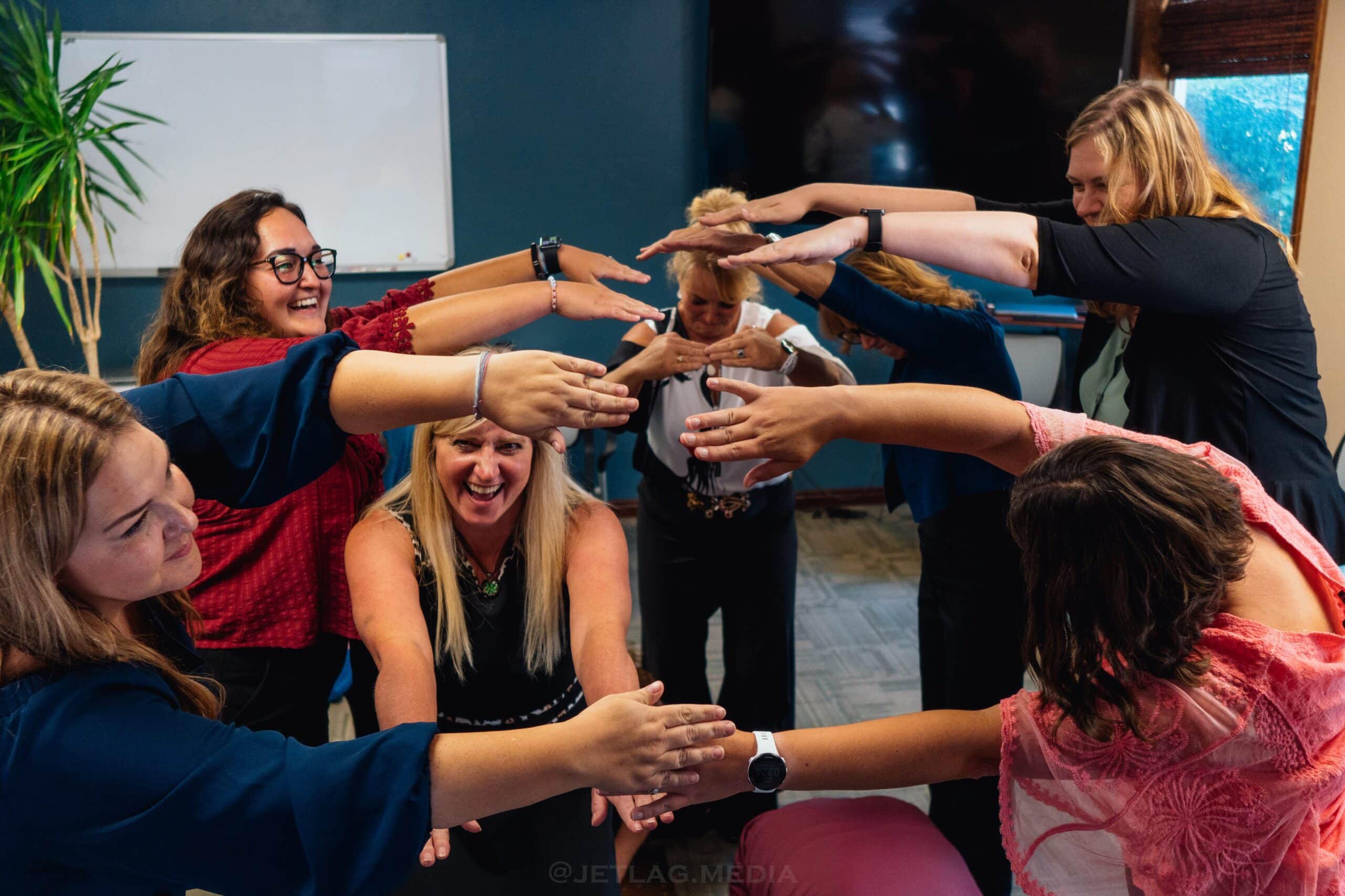It is crucial for businesses to establish a culture of teamwork and collaboration. Team-building exercises, communication training, and incentives for collaboration and cross-functional work can help achieve this. Employees may utilize each other’s talents and abilities by working as a team, resulting in better outputs and more company success. Improvisational workshops are already entering the business world as a technique to enhance the teamwork and leadership abilities of the business workforce.
Improvisational theater is a long-standing style of entertainment where scenarios and tales are created from provided suggestions of the audience. This needs the performers to be extremely creative, spontaneous, and collaborative. This technique was adopted in business to assist employees in developing creativity, communication, cooperation, collaboration, and flexibility in the workplace.
The principles of an improv workshop urge participants to be present, involved, and open to new ideas and viewpoints.
- Say “Yes…And” – Learning to comprehend and accept someone’s notion by answering YES… And incorporating their thoughts into your head even if they are totally opposed to what you have in mind. This concept assists the workforce in not competing with the idea of one team member, but rather in attempting to understand the individual and building his idea to connect to others. Participants in an improv workshop learn to say “yes, and” to one another’s ideas in order to develop scenes and stories together.
- Active Listening – Listening is vital in improv, as a performer, she or he must be attentive to what others are attempting to say in order to connect and contribute to their performance. In utilizing improv workshops, participants are honing their ability to actively listen and respond truthfully to what they hear.
- Collaboration – Participants in an improv workshop gain the ability to collaborate with others, building on each other’s contributions and ideas.
- Risk taking– Unexpected events frequently occur in the course of business, although they may first appear to be errors, they may really be the start of a wonderful scenario if you can adapt to them and build on them. Improv workshop refines participants’ capacity to take a risk and be willing to make mistakes. Here, participants learn to let go of their inhibitions and take chances, believing that their team members could help them build a solution for an unexpected mistake.
- Playfulness – Being a member of a business means you never know who you’ll be working with, and you’ll be dealing with a fresh set of personalities and working relationships. And it is critical that someone understands her/his function in order to create a pleasant working environment. Participants can become more creative and open-minded in their thinking by embracing the spirit of play.
Here are three typical improv workshop exercises that are both enjoyable and valuable to the business’s workforce members.
1. Make a wave – It needs 10 members, and it takes 10 minutes to perform the activity. This is very helpful in overcoming communication barriers toward success.
Procedure
- Identify those in the group who have experienced or witnessed a “wave” at a sporting event. (The majority of individuals will nod or put up their hand.)
- Request that someone describe a wave and how it works.( A few people will stand and raise their arms; it takes some time for others to join in, but ultimately the wave moves over many sections or maybe the entire stadium.)
- Tell the group to make a wave that moves all over the space. An individual or group of persons cannot be skipped by the wave. Restart until the wave has passed each individual. Add another obstacle: no chatting!
Group Debriefing
- What happened? (difficulty, unsure of where to begin, lack of a designated leader)
- What was most difficult? (We couldn’t communicate, so we weren’t in a complete circle.)
- What did you do to achieve success? (many hand gestures and eye contact; persistence; each time, we improved as we discovered what worked and what didn’t)
- What parallels do you notice between making a wave and making change in your team or organization?(works best when it is organic and non-hierarchical; everyone must be on board if it is to succeed; the value of trial-and-error)
2. “Yeah, but” vs. “Yes, and” – It takes 15 minutes and it only needs two participants. Accepting and bringing ideas forward, expanding on ideas rather than shutting them down, unleashing group intellect, teamwork, and problem solving.
Procedure
- Divide the groups into two pairs
- Exercise A. Describe how Person A proposes a solution or an idea. (e.g.”We need better customer metrics.”) A challenge to the concept or solution is made by Person B in response to the question “Yeah, but…” (e.g. “Yeah, but our technology is so dated.) A counter-proposal is then made by B. (e.g. “We need to review our entire corporate strategy and ensure that it is more in line with the needs of our clients.”) Person A replies, “Yeah, but…” followed by a justification or objection to the notion (e.g. “Yeah, but senior leaders need to lead this effort”).
- Repeat 2-4 rounds
- Exercise B. Person (A )offers a recommendation, and Person (B) adds to it by saying “Yes, and…” In agreement with (B’s) contribution, (A) replies, “Yes, and..” and adds another recommendation to back up the first one. “Let’s make our team meetings more productive,” (B.) “Yes, and instead of 60 minutes, let’s schedule them for 45 minutes.” (A.) “Yes, and let’s send out a brief, bullet-point agenda the day before.” (B.) “Yes, and let’s require anybody who arrives late to perform a song.”
- Be clear about the rules; refrain from debating or challenging them. There should be no hesitation or searching for the ideal addition. Simply add “yes, and” and any other relevant information.
- Repeat 2-4 rounds.
Group Debriefing
- What did the two versions vary from one another? What was unique about the caliber of the ideas?
- What circumstances are most likely to result in “yeah, but”? What happens when “yeah, but” is used as the standard?
- How can you encourage more “yes, and” in your team interactions?
- A few more things: “But” is another way of stating “no,” which is frequently our default position. It stops the problem-solving process and keeps the debate going in circles. People feel heard, appreciated, and included in the solution when they hear “Yes, and…” It takes a more flexible and positive approach toward disagreement and conflict. You may show that you understand by saying “Yes, and…”.
3. Physical Telephone – It requires 15 minutes and 6 participants. Helpful if they struggle with “cascading” communication, overcoming communication barriers, and the necessity of basic and straightforward communications.
Procedure
- Place 6–8 participants in a line, all facing the same way. Extras are allowed to watch from the sidelines and join the line in the subsequent round.
- Walk to the back of each line, tap the person at the end of the line on the shoulder, and demonstrate three different (polite) physical movements. Make big motions and switch your body sides. Avoid using gestures that are already common, such as the thumbs-up or the wave.
- The final person in line turns around, touches the person in front of them, and makes the movements without saying a word. When done, they leave the queue and look around. (The gesturer is unable to mimic the motions. The person in front must do the movements as best they can recall.)
- Continue down the line until the gestures reach the person at the front of the line.
- As you both turn to face the group and simultaneously make the appropriate gestures, invite the person in front of the line to join you. (The motions used at the end will probably change greatly from those used in the beginning.)
- Repeat by mixing up the order of the line.
- Optional: In the final round, remove the constraints so participants can talk and/or repeat gestures for clarification.
Group Debriefing
- What happened? Why did that happen? (Remembering was difficult, I made up what I forgot, the gestures changed every time, and even a small adjustment may have a significant effect on the outcome.
- How does this compare to how communication operates in your group or organization? (We frequently lose contact with all stakeholders because we rely on the hierarchy to provide us with information.)
- What effects/results did it have when we removed restrictions (allowed to talk/repeat gestures)?
- What are the dangers of “cascading” communication—that is, the transmission of knowledge from one person or organization to another—in this day and age?
- Why do we rely on this in organizations? What are other methods to ensure people get accurate information?
By utilizing improv activities or engaging in a workshop in your workplace, participants increase their creativity and push them to think beyond the box. Participants may improve their creativity and innovation abilities by exercising spontaneous thinking and adopting new ideas. It improves communication, adaptability, and the importance of cooperation. It promotes collaboration and trust, which leads to improved teamwork abilities. Participants in improv exercises must collaborate and encourage one another, generating a sense of community and teamwork.
Connect with us today to learn how to create space for Improv Workshops for your team and unlock your workforce’s leadership potential and increase your team collaboration in your business.
Check out our FREE resource: 14 Tips to Make Your Message Memorable and make simple actionable steps towards your speaking goals immediately.


